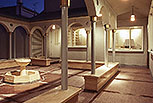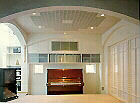The sound of water dropping from the fountain echoes in the patio encircled by cloisters. The architect of this house, Takeo Kamiya, says,
"There are many hardships and sorrows in human lives. Sitting on a bench in the courtyard isolated alone and still from the outer world and bending an ear to the sound of the fountain might heal his or her troubled mind."
"A house should possess an impressive space, which deeply engraves on one’s heart in the process of growing as a person."
He, who is profoundly captivated by Romanesque architecture, which gives him not only sensuous satisfaction but also spiritual gratification, had been wanting to apply to his design a space-composition of a ‘patio encircled with cloisters’ since long ago.
The client did not like houses, where brilliant rays of sun pour in plenty, rather demanding mild and homogeneous light in the house, and his wife wanted a plan where she would be able to spend daily life with her children instead of doing housework, such as kitchen work, in isolation. It was thus I designed this ‘Cloisters House’.
 
Left : Looking down at the Patio from 2nd floor terrace
Right : Night view of the Patio with a basin enclosed by Cloisters
The site is located in a residential district on a high ground in the city of Nagoya, extending north and south 10m in width and 38m in depth. The plan of the house consists of the northern, western and southern wings surrounding an open space, which became like a courtyard by being closed on the eastern side with a frosted glass screen and an arcade that continues to the other three sides just like the complete cloisters of a Romanesque monastery, though on a much smaller scale.
The open kitchen, connected to the dining space and living room, is set in the western wing, where the wife can cook with looking to the courtyard and peeping the children’s room in the north wing beyond the courtyard, and also being able to feel the atmosphere of the 2nd floor through the void space over the dining space. That is, the kitchen is the nucleus point of this house. Though the husband is the executive officer of a company, which his late father inaugurated, he values family life more than inviting guests of business, making such a plan to be possible.
The client couple, who look upon child rearing as important, did not want to give each child a single room from early on, but had an idea that the children would create their own areas in the wake of their growth. Therefore, the three children would start living together in one room, and as the years go by they would occupy some space or add a new room outside. There is also a plan to live together in the future with the client’s mother, saving enough space for enlarging the house on the north, road side of the site.
 
Vestibule Living room
As for the courtyard, it was based not only on Romanesque monasteries but also Moroccan patios. When Mr. Kamiya showed photographs of many countries’ courtyards to the client, it seemed to him that the client was highly fond of Moroccan patios, which were overall made of stone with no earth or greenery. He consequently designed the stone courtyard as a man-made environment, expecting the family to take meals or drink tea here.
Although he did not think that this first concept would be easily accepted, all the more for Mr. Kamiya’s strong passion for such a courtyard, he was able to mostly carry out this plan, only enlarging the span of the northern wing and instead removing the small basement. Spaces such as cloisters apt to be cut as a waste of money, but the client, who wished for a house with some playfulness or freedom, simply approved this plan, almost anticlimatically.
Mr. Kamiya, who had often considered even the details of courtyards, concluded to say that he desired to design courtyard houses as a series, even though it would not be easy due to the difficulty of obtaining a large piece of land in Japan.
( Translated from Japanese by Takeo Kamiya )
|








